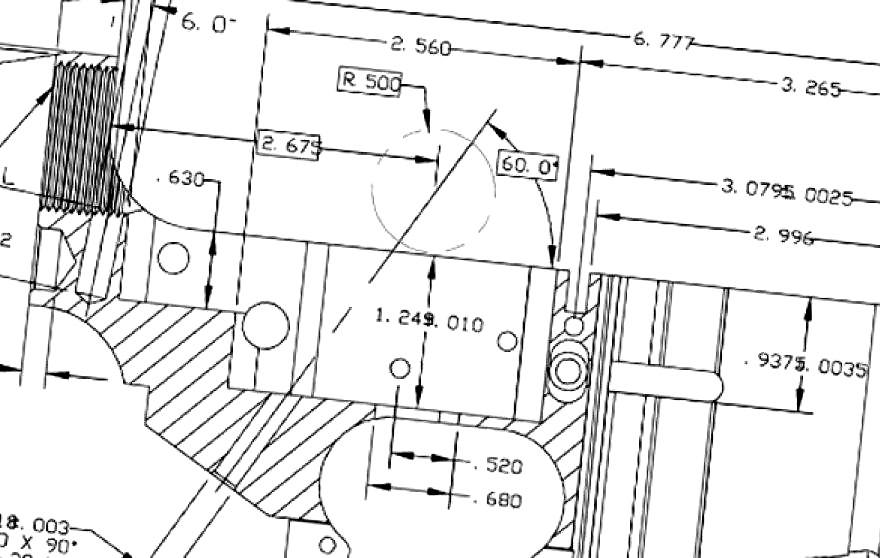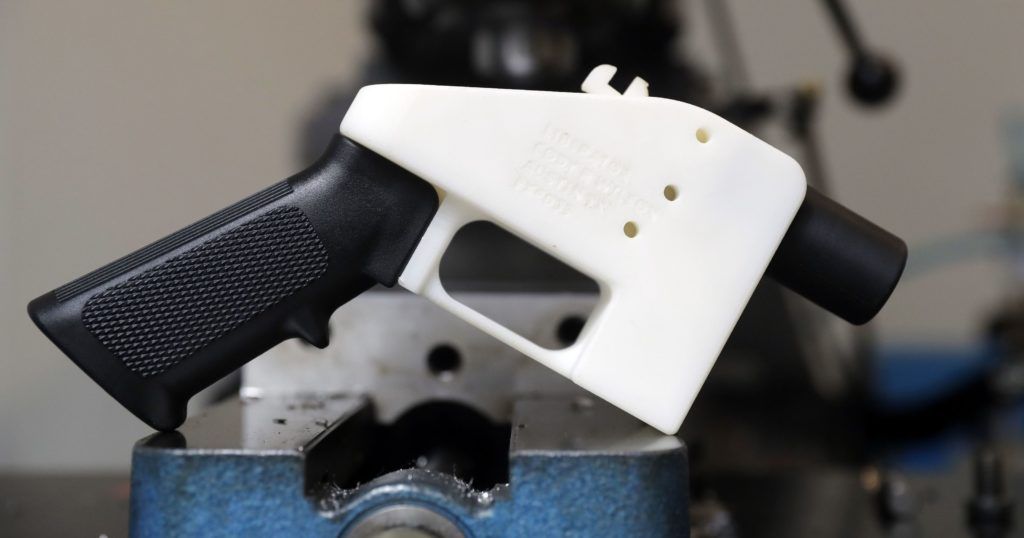Defense Distributed: Is There a Future for Gun-control?

The essay is about the explosive issues surrounding Defense Distributed, a company that develops virtual blueprints of guns that anyone can download and use to print a gun at home, in a 3d printer. Most importantly, it is about additive manufacturing and its potentially huge impacts in society and does not intend to take a side on any political issue or on the merits of people or organizations represented in it.
On the wake of another sequence of tragic events in the United States, gun-control takes over public debate once again. Proponents of gun-control argue that the lack of it is what stands between the US having cities like Baltimore and St. Louis, with murder rates multiple times higher than those of places like Colombia or Brazil, and the very low murder rates of other developed nations. On the other side of the aisle, pro-gun activists argue that the right to bear arms is a fundamental right of American citizens, one that cannot be given up without compromising freedom itself.
Nevertheless, polls show that Americans in general want more gun-control. According to a Gallup Poll from October 16, 2017, 60% of Americans agree that the law on firearms should be more strict, 70% supported requiring all guns to be registered with the police and an astonishing 96% supported background checks on all gun purchases.
Despite such strong consensus among the general populace, an organization promises to disrupt gun laws anywhere governments try to enforce them.
Meet Defense Distributed.
Every citizen a gunsmith?
 Defense Distributed is a non-profit organization whose main goal is to preserve the right to bear arms. They try to do that by developing digital models for firearms that can be downloaded and used to “print” a firearm by anyone who owns a 3D printer.
Defense Distributed is a non-profit organization whose main goal is to preserve the right to bear arms. They try to do that by developing digital models for firearms that can be downloaded and used to “print” a firearm by anyone who owns a 3D printer.
What Defense Distributed seems to really want though is to destroy gun-control once and for all by making it unenforceable.
For the organization, additive manufacturing is not only important: it is the technology that actually enables them to exist and have such an ambitious goal. It has characteristics such as a distributed and potentially discrete nature [2]; it requires much less sofisticated skills to operate a printer using blueprints than to manufacture machine parts in a traditional setting [5]; the raw materials it uses are common and very hard to trace. All of this allow Defense Distributed to empower anyone to potentially become a completely invisible gunsmith, immune to restrictions on the manufacturing and commercialization of guns.
Freedom-fighters or merchants of death?
 The history of Defense Distributed is a clear example of how the challenges faced by organizations adopting new technologies can go far beyond merely dealing with the technical obstacles to adoption: societal resistance to technological change might be the biggest obstacle of them all.
The history of Defense Distributed is a clear example of how the challenges faced by organizations adopting new technologies can go far beyond merely dealing with the technical obstacles to adoption: societal resistance to technological change might be the biggest obstacle of them all.
Since its founding in 2012, Defense Distributed has been facing all kinds of challenges from public and private actors, from boycotts [3] to legal challenges [4]. The organization has been dealing with those challenges through public relations efforts, portraying itself as a defender of what they consider a fundamental freedom and as democratizers of manufacturing capacity [5], and through legal action, fighting efforts by the State Department to shut them down and from a former business partner that sued them for using a leased 3D printer for activities it deemed illegal [6].
In the long term though, DD main defense against its critics is technological. After a long series of court battles that culminated in a settlement with the State Department in which DD agreed not to put gun blueprints for download for free, Defense Distributed decided to distribute its models through email and even physical pen-drives, in a pay-what-you-want model [7]. It continues to focus on developing virtual models rather than the hardware for additive manufacturing, in a way that echoes the software prevalence against hardware in the dilemma faced by the earliest tech giants decades ago.
Is Defense Distributed defensible?
The two main ways Defense Distributed could face the challenges to its business model are diametrically opposed.
One way would be for Defense Distributed to continue leveraging technology so as to make it impossible to regulate. Focusing on blueprints helps, but it could also partner with a manufacturer of 3D printers to develop and distribute an optimized “gun printer”, truly “plug-and-play”, which would make it easier to use and more popular.
A second way DD could deal with its opponents is, of course, by complying with their demands. If it is really more than guns, but “…about democratizing manufacturing technology”, there are a lot of ways it could pursue this mission without putting AR-15 equivalents in the hands of people that might not be the best among us to have access to those.
A couple of questions remain open as DD keeps pushing forward: first, should the company’s distribution of CAD models that are going to be turned into guns be protected as speech? Second, is it even possible to deal with perceived negative consequences of technology through regulation or is technological advancement just untamable?
No matter what one’s opinion is on Defense Distributed’s endeavor, it is clear that understanding it is key to understand crucial questions about the future of technology. (795 words)
References
[1] Gallup (2016). Americans Widely Support Tighter Regulations on Gun Sales. [online] Gallup.com. Available at: https://news.gallup.com/poll/220637/americans-widely-support-tighter-regulations-gun-sales.aspx [Accessed 09 Nov. 2018].
[2] Molitch-Hou, M. (2016). A Look at the Distributed Manufacturing Future of 3D Hubs. [online] Engineering.com. Available at: https://www.engineering.com/BIM/ArticleID/13127/A-Look-at-the-Distributed-Manufacturing-Future-of-3D-Hubs.aspx [Accessed 10 Nov. 2018].
[3] Schroeder, A. and Valens, A. (2012). Indiegogo shuts down campaign to develop world’s first printable gun | The Daily Dot. [online] The Daily Dot. Available at: https://www.dailydot.com/news/indiegogo-3d-printed-gun-campaign/ [Accessed 09 Nov. 2018].
[4] Defense Distributed v. United States Department of State. (2018). Harvard Law Review, [online] 130(06). Available at: https://harvardlawreview.org/2017/04/defense-distributed-v-united-states-department-of-state/ [Accessed 10 Nov. 2018].
[5] Brown, R. (2012). You don’t bring a 3D printer to a gun fight — yet. [online] CNET. Available at: https://www.cnet.com/news/you-dont-bring-a-3d-printer-to-a-gun-fight-yet/ [Accessed 10 Nov. 2018].
[6] Beckhusen, R. (2012). 3-D Printer Company Seizes Machine From Desktop Gunsmith. [online] WIRED. Available at: https://www.wired.com/2012/10/3d-gun-blocked/ [Accessed 13 Nov. 2018].
[7] Osborne, C. (2018). Defense Distributed now sells 3D gun blueprints online, ‘pay what you want’ | ZDNet. [online] ZDNet. Available at: https://www.zdnet.com/article/defense-distributed-now-sells-3d-gun-blueprints-online/ [Accessed 09 Nov. 2018].




A really thought-provoking topic, and frankly, scary as hell.
To the question of whether or not CAD drawings for printable guns can and should be protected as speech to me, is unequivocally no. In the same vein that obtaining instructions and materials to build bombs, or possessing explicit images of minors is highly illegal, so to should be this. The fact is, these things do tremendous, tangible damage.
The next logical question is of course how do we police this? While not perfect, I would look to AI technologies to monitor the potential illicit circulation of such files. In a similar manner to how Facebook has flagged over 2 million instances of potential terrorist activity across its platform, one could automate the flagging process of circulation here.
I’m with N. here, but I wonder whether there may still be opportunities for Defense Distributed to succeed as a business and support better gun use without increasing the distribution of illegal guns.
First, they could work with the Governments to create a legal and technological framework this is consistent with current (or proposed) gun laws. Depending on the country, this could involve locking down the technology so that it can only be used by the purchaser for the agreed quantity and requiring background checks and Government licenses to access the technology. This technology could also be used to require unique tracking numbers on each gun and unique barrel markings to be produced on used bullets. This would allow regulatory and policing agencies to monitor the use and distribution of these guns and more easily link illegal use of this guns with the purchaser of the guns.
Second, they could introduce new safety features on their guns that may not be feasible due to the variability in traditional manufacturing processes.
Third, they could innovate their product to tailor it to specific uses, where they may not necessarily be large scale. For example, they could produce designs for guns designed exclusively for farmers in specific settings.
Incredible article. Super interesting, and so scary. I remember thinking that gun control was over when I first read about Cody Wilson’s desktop CNC mill for machining AR-15 lower receivers – the part that gives the rifle the legal designation of gun. I’m sure you’ve already checked out: GhostGunner.net
Most people believe gun control should be more strict, so it’s sad to think that technology which poses immense benefits has also the power to put tools of death in the hands of anyone with a computer. Especially as more information continually is surfaced about the Russian funding of the NRA – a pro-gun policy advocacy group – it’s hard to imagine gun law becoming any more rational.
One big question I have: if a Defense Distributed weapon is used in the killing of a person, does Cody Wilson go to jail? Is the company liable? Even if they are legally allowed to distribute plans and tools to make guns. If those guns are then used to kill people (because the owners skirted regulations or background checks), can the company, or individuals within be prosecuted?
Definitely a scary yet fascinating topic to think about.
It’s interesting that Defense Distributed is a non-profit – it really highlights their motives of democratizing access to firearms.
I agree with N about the designs not being protected as speech but rather classified as illegal, explicit material. I am at a loss for what regulations or policing could be applied to something like this. It seems as if there’s nothing stopping anyone with access to a 3D printer from building metal-less firearms with Defense Distributed’s plans, but like the ideas proposed around machine learning to flag potential uses of the blueprints.
I generally agree with N. and Alan here, except on the point of whether CAD drawings for printable guns can be protected as speech. The difference between those drawings and instructions to build bombs or explicit images of minors is precisely the 2nd Amendment (or at least the Supreme Court’s presiding precedent on what the 2nd Amendment allows for). This is why Defense Distributed is allowed to distribute their materials under the specific limitations the company faces today.
While I believe that there are absolutely responsible ways for DD to exist, tt seems clear that their mandate is to make gun control useless/ difficult to enforce. I think it’s on the government to place controls on gun manufacturers and to place safety limitations on what kinds of guns can be produced by 3D machines legally.
Very interesting article. I agree that this is very scary and frankly terrifying in todays world, yet I do disagree with N. in the sense that creating a blue print for a gun does not differ from creating a blue print for a potato cannon or a sling shot. I disagree with Defense Distributed and their cause, yet we cannot treat DD different that we would for any other prototype. I believe though that the government should intervene in the 3D printer to introduce a red flag or even prevent the user of the printer to print gun relating materials, in the same way that current scanners and printers prevent users from copying treasury notes. I think gun printing is scary and dangerous, but I do not think that DD should be judged for placing blue prints of how a gun work.
Interesting article about 3D printing and how it applies to the broader political climate (i.e., gun control in the US). I’m with a similar opinion as expressed in previous comments – this technology for 3D printing guns is absolutely terrifying. There’s no clear way for anyone to regulate such a technology and the “pay what you want” model makes this gun easily accessible to anyone with internet access. As 3D printing becomes more pervasive and affordable (e.g. a functioning 3D printer can be purchased at Walmart for $169 USD), there is an increased likelihood that people with malicious intent (and whom normally would not pass a background/safety check) can easily make their own guns at home to cause harm.
This technology needs to be made illegal with severe consequences attached to offenders.
Very thought-provoking article with a nuanced and balanced take on the philosophical questions being raised on both sides of the fence. Agree with AT’s comment on the solutions that can be layered into the business model to reduce misuse, but all of these involve some aspect of external control and thus seem incompatible with Defense Distributed’s mission of democratizing access to firearms as a fundamental right. This article, to me, also recalls the debate around how scientists and technologists can balance the free pursuit of ideas with cognizance of the destructive fallout of some of these advancements. While 3D printing does not trace its development to a destructive intent and has limited potential to inflict damage on a wide scale, the increasing pace of technological advancement and its rapid diffusion into daily usage raises questions of the role that governments should play in anticipating and pre-empting such applications. A broader question is whether even governments can unilaterally self-legitimize their decisions to use technology for destructive applications, for instance, use of drone technology in strikes that hit civilian populations, and the global approach needed to ensure that future technological advances are used for good rather than harm.